|
The
museum’s vehicle collection, and Vehicle Restoration Group
The Black Country Living Museum is home
to the world’s largest collection of Black Country-made
vehicles, which are lovingly cared-for, and restored by the
museum’s Vehicle Restoration Group. |
|
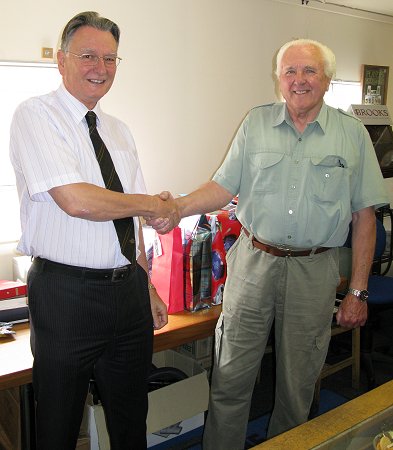
Ian Walden and Ray Jones. |
The museum had a small collection of vehicles, which was
greatly enlarged in 2001, when the Chief Executive at the
time, Ian Walden, managed to acquire a large number of Black
Country made cars, motorcycles, and even a fire engine, for
the museum.
The collection was purchased from the Marston
Wolverhampton Heritage Trust.
Ian realised that in order to run some of the vehicles
around the museum site, they would need proper attention,
and so the Vehicle Restoration Group was formed.
The group of volunteers was originally led by the
museum’s Honorary Curator of Vehicles, Ray Jones, who has an
in-depth knowledge of everything to do with locally made
vehicles, from the manufacturers and their various models,
to engines and mechanical intricacies. |
| Under Ray’s leadership, the group restored and
overhauled many of the vehicles in the collection, and they
became a familiar sight at the museum. The vehicles were
originally on display in hall 2 in the Rolfe Street baths
building, and were always a popular sight. The group also
occasionally opened the bicycle shop, which was in the
museum’s village. |

Some present and past members of
the Vehicle Restoration Group. Left to right: Brian
Rollings, Stan Davis, Malcolm Webster, Beryl Jones, Ken
Norton, Audrey Spencer, John Vincent, Ray Salisbury,
Derek Spencer, David Beere, and Maurice Withers.
|
|
Ray and the group were also involved in
several projects at the museum. The first project was the
building of a replica of Conway Garage, which was run by
ex-Sunbeam racing mechanic Alec Broome, at Fighting Cocks,
Wolverhampton. It opened in July 2008 and is an impressive
exhibit. A typical Black Country garage of its time. It
houses several of the vehicles from the collection. |
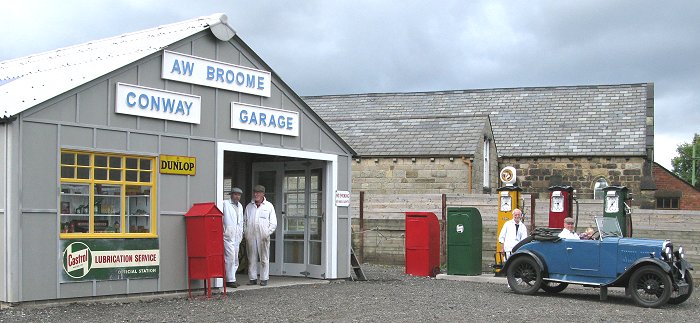
Conway Garage. In the doorway is
Ken Norton and Stan Davis. Ray Salisbury is at the
pumps, and Derek Spencer is in the driving seat of the
A.J.S. car. |
| The next project in 2008 and 2009 was the Bradburn and
Wedge garage, which now houses the bulk of the vehicle
collection. The garage, based on the Bradburn and Wedge
garage that stood in Darlington Street, Wolverhampton,
opened in February 2009. As well as the collection, it
houses the up-to-date workshop that is used for vehicle
restoration. The last project, a replica of
A. Hartill & Sons motorcycle shop, which was at Mount
Pleasant, Bilston, opened in July 2010. It is part of the
development in Old Birmingham Road, which includes
several new shops, and the new fish and chip shop.
The new motorcycle shop houses some of the motorcycles from
the collection. |
|
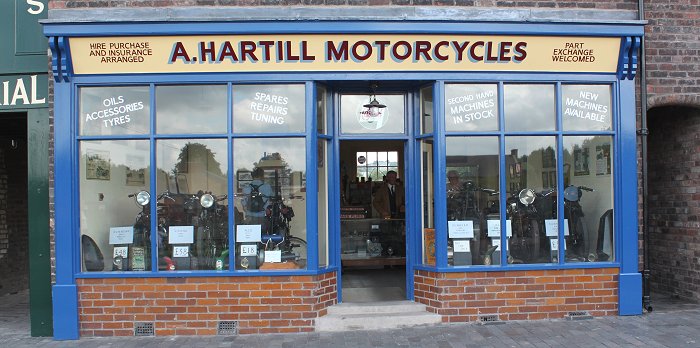
The motorcycle Shop. |
| Ray Jones retired in September 2010, and
the leadership of the group was taken over by Brian Rollings.
The group continues to restore and overhaul many of the
vehicles in the collection, to ensure that they will
continue to be a familiar and impressive sight, travelling
around the museum. The vehicles can sometimes be seen in
action on Thursdays, when the group meets, and on the first
Saturday in every month, from March to October. They are
also used on special occasions, and functions at the museum.
The group also helps to organise the museum’s annual vehicle
rally which is held in July. |
|
The Museum’s Briton 10/12 car
The Briton Car Company
was founded in Wolverhampton in 1909 as a subsidiary of the
Star Engineering Company, which produced vehicles
under the Star name. In 1913 Briton moved to a new
purpose-built factory in Lower Walsall Street,
Wolverhampton, where the museum’s Briton car was built. The
car, a 1914 Briton 10/12 hp. 4-cylinder, Special Car, with a
streamlined body, is the only known survivor of its type. As
far as is known only 12 Briton cars survive, six in the UK,
and six in Australia and New Zealand. |
|

Brian Rollings at the wheel of the
Briton car. |
|
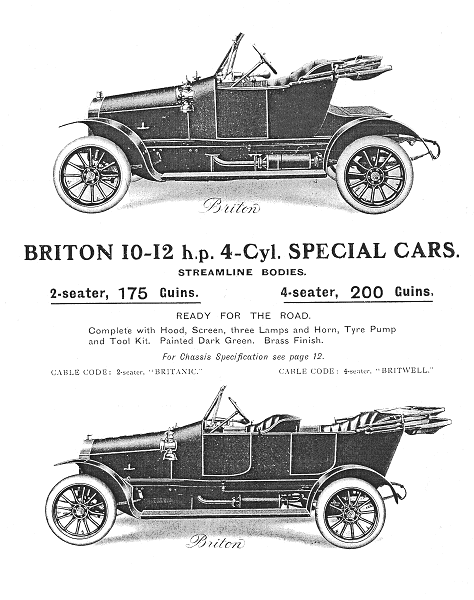
From the 1914 Briton catalogue. |
The car’s early history is unknown.
Throughout the First World War Briton made many military
vehicles. During restoration, a W.D. sign was found on the
crank case, so the car could originally have been a military
staff car.
The car was purchased at auction by Marstons around
thirty years ago. It is believed that the previous owner
lived in London.
Some work was done on the car during its time at Marstons,
but when it was acquired by the museum, it was partly
disassembled, and many parts were missing. This led to a
challenging restoration. |
|
The
restoration
Several members of the Vehicle
Restoration Group were involved in the restoration. They are
David Beere, Ray Jones, Ken Norton, Brian Rollings, Ray
Salisbury, John Vincent, and Malcolm Webster. |
|

Some time before restoration began,
the car was removed from a container, in which it had stood
for several years. |
| This was a difficult project, because no photographs or
drawings of this model survive, other than a relatively poor
illustration in the Briton catalogue. Missing parts included the
running boards and mudguards, and so Brian Rollings produced
drawings based on the catalogue image.
He also produced a drawing of a scuttle-mounted petrol
tank, after discovering that a replacement was necessary. |
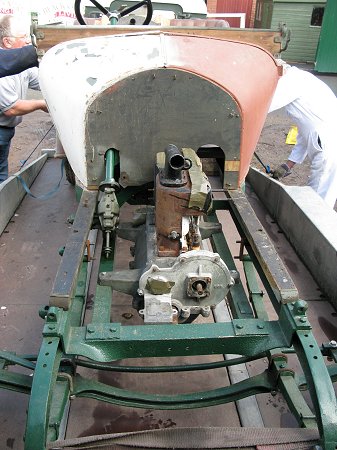
The front of the car before
restoration began. |
|
Mechanical overhaul and rebuild
Luckily the group includes several
extremely skilled engineers, who were able to construct the
missing parts, and adapt other parts to fit. The chassis was
in good condition, and some work had previously been carried
out on the engine, including a rebore, and new pistons. |
|
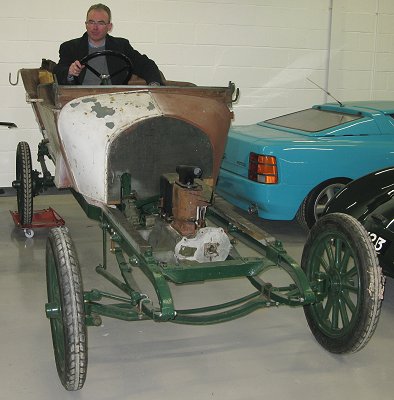
Awaiting restoration in the Bradburn
and Wedge garage. |
The crankshaft had been reground, and
the bearings re-metalled, but new valves had to be found,
ground-in, and fitted. The water jackets also had to be
assembled. Most of the work on the engine, gearbox, clutch,
rear axle, and brakes was carried out by Brian Rollings and
Ray Salisbury.
Unfortunately the timing gear was
missing, but luckily David Beere, an exceptionally skilled
engineer, was able to make a replacement. Another missing
part was the magneto. A suitable one was found, and David
adapted it to do the job.
It was found that the rear axle had
previously been taken apart, and assembled back to front. So
this had to be taken apart and correctly assembled.
New thrust bearings, and withdrawal
mechanism were made for the clutch, the gearbox was fitted,
and the oil pump completely rebuilt. A new silencer was made
by Malcolm Webster and fitted by Ken Norton. |
|
Bodywork
One of the group members, Malcolm
Webster, is an exceedingly skilled metalworker. He carried
out a lot of work on the body, including fabricating new mud
guards, fitting new running boards, restoring the side
panels, and the bonnet, and re-skinning the doors. The
missing woodwork was made by Ken Norton, and a missing door
was made by Ray Jones. |
|
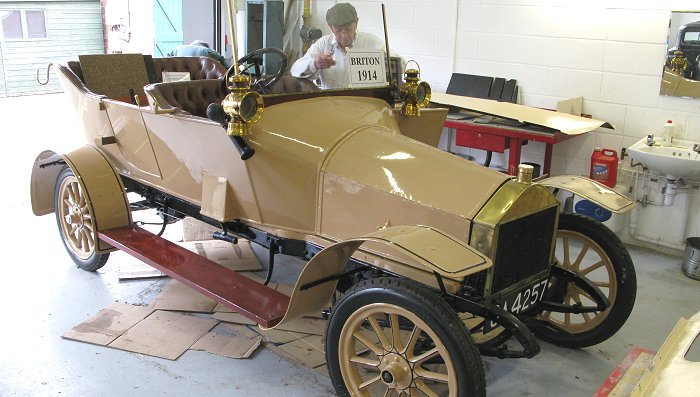
John Vincent at work on the nearly
finished car. |
| The completed body was painted by Ken Norton, who
applied, and rubbed-down 15 coats of paint. John Vincent
fitted the internal vinyl, and Malcolm Webster brazed the
broken brass frame holding the windscreen, and fitted the
windscreen. |
|
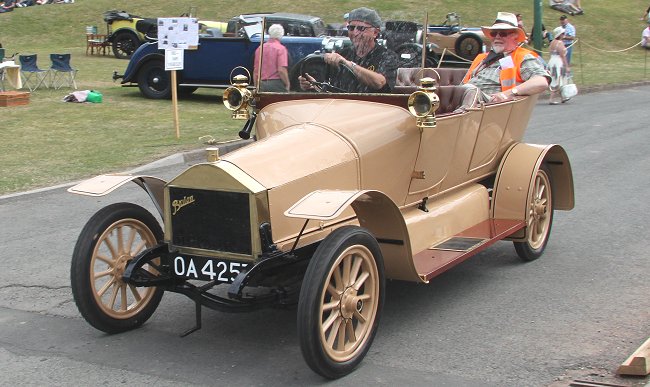
The car's first public outing at
the 2011 Festival of Black Country Vehicles. |
|
All-in-all it was a fantastic team
effort. When everything had been done, the car was towed for
10 yards, and it started first time. This was the group’s
first complete car restoration at the museum. They are an
extremely enthusiastic and versatile team, who will no doubt
continue to ensure that the museum’s unique vehicle
collection will be well-cared for, in years to come.
Current members of the volunteer group
are Roger Marks, Ken Norton, Keith Peckmore, Brian Rollings,
Ray Salisbury, Audrey Spencer, Derek Spencer, John Vincent,
and Malcolm Webster. |

A final view of the car in action at the
museum.
 |
Return to
the
previous page |
|